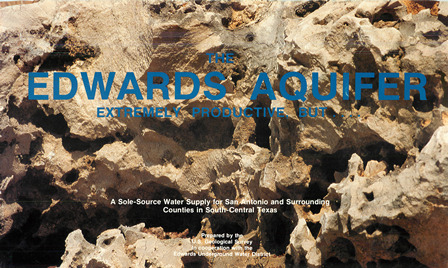The Edwards Aquifer Extremely Productive, but…

| Author | Burchett CR, Reettman PL and Boning CW (US Geological Survey) in cooperation with the Edwards Underground Water District |
| Year | 1986 |
| Description | Semi-technical description of the Edwards aquifer and considerations for its use and preservation for the general public and policy-makers |
| Publisher | US Geological Survey, Edwards Underground Water District |
| Location | Edwards Aquifer - General |
| Cover | View Download |
| File | View Download |
| Summary |
|
Note: This report is included for its historical value and may not reflect current scientific understanding of the Edwards Aquifer. This report…is a compilation of technical information presented in a manner to be useful to the lay reader and particularly for the decision-makers of the region. It is intended to bridge the gap between the basic information contained in a textbook, Water, Water Conservation and the Edwards Aquifer and the numerous technical reports of the District and others. The need for protection of the Edwards Aquifer water quality and the growth of this region with the resultant increasing demand for the water resource, requires a greaterunderstanding of the Edwards Aquifer by all and how it should be protected and managed. The publication of this report will further the general understanding of the Edwards Aquifer and assist everyone in their efforts to reach decisions on the future of our water resource. Continued economic development in south-central Texas will depend upon the available water supply. The principal source of water for San Antonio and the surrounding area will continue to be the Edwards aquifer, although supplemental supplies will need to be developed. Intelligent management decisions concerning how, when, and where to develop the additional water supplies can be made only if pertinent data concerning the total water resource are available to the decision makers. Information needed by elected officials and professional water managers include: Rainfall-runoff data on surface streams, maximum potential recharge to the aquifer, storage capacity of the aquifer, movement of water through the aquifer, and safe withdrawal rates. It is readily recognized that the future supply of water provided by the Edwards aquifer will have a significant effect on continued economic development in south-central Texas. Most decision makers agree that alternative water development will be needed to accommodate increased economic development. However, there may be disagreement on the most reliable and cost-effective means of developing alternative water supplies. Supplementing ground-water supplies by constructing surface water reservoirs and increasing the ground-water supply by enhancing recharge are being considered. Conservation measures have been introduced throughout the area and discussion has begun on considering a water reuse program. The decision makers–the elected public officials and the professional water managers-need information concerning the hydrology of the Edwards aquifer to select the most suitable plan of water development. The first of many critical decisions is to determine if existing hydrologic information, knowledge, or data are adequate for selection of a proper water development plan. Subsequent decisions regarding the implementation of plans for supplemental water development also will require detailed information about the aquifer. Information needs include data for determination of the maximum recharge potential and the maximum quantity of water that can be safely withdrawn from the aquifer during periods of various climatic conditions without endangering the quality of the resource and without causing severe hardship for the many various water users. Investigations of the Edwards aquifer are necessary to obtain these data. To make timely and critical decisions, the planners and water managers need to have knowledge and understanding of many specific and related technical hydrological considerations such as: Quantity of precipitation and its distribution in time and space, an understanding of the recharge mechanism, how water is contained in and moves through the aquifer, the quality of water in the aquifer and the potential for contamination, and the effects of temporary partial depletion of water in storage during droughts. The report has been prepared to enhance the public’s general understanding of the Edwards aquifer, and to aid officials in making decisions about the aquifer. The report also is intended to identify limitations in the understanding and knowledge of the aquifer, thereby facilitating the planning of investigative programs. This report is not intended to provide solutions to currently prevailing unanswered questions. |
Search for Documents
Advance Search
Explore EAA's Scientific Reports
- All Reports
- Surface Water / Groundwater Relationship
- Biology
- Springs, Groundwater Discharge
- Archaeology
- RZ Protection
- Aquifer Levels
- Remote Sensing
- Precipitation
- Overview Studies
- Modeling
- Hydrology and Hydrogeology
- History
- Groundwater Recharge, Recharge Zone
- Groundwater Movement
- Geomorphology and Caves
- Weather Modification
- Geology
- Water Use and Conservation
- Geochemistry
- Water Resources Planning and Management
- Floods and Drought
- Water Quality
- Climatology
